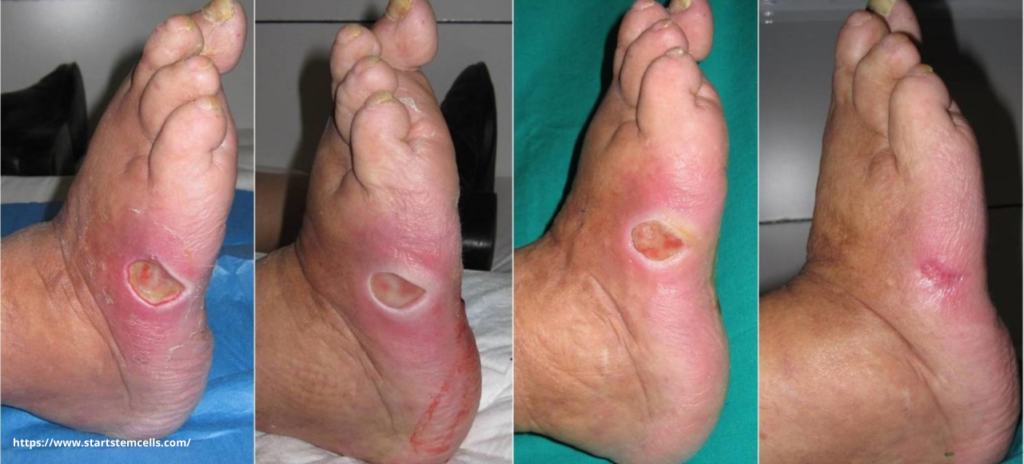Diabetes is severe complication among people in Ghaziabad. They may develop a variety of foot problems.
The increased risk of diabetic foot problems in people with diabetes develops due to two main conditions:
- peripheral artery disease (PAD) and
- peripheral neuropathy.
Diabetic foot complications symptoms like reduced sensitivity occur due to nerve damage and a lack of oxygen supply to your feet.
People who suffer from diabetes are more likely to develop ulcers and have damage to their feet.
Bunions, corns, calluses, hammertoes, fungal infections, dry skin, and ingrown toenails are common diabetic foot problems. These issues are not always related to diabetes, but they may become more complicated if you suffer from diabetes-related nerve and vascular damage.
As per our diabetologist in Ghaziabad, the treatment for your type 2 diabetic foot problem depends on the seriousness of your complications. In some cases, you may require surgery or even amputation.
You can suffer from gangrene as well. Lack of blood circulation into your tissues increases the chance of developing gangrene. You should keep in mind that if a bacterial infection occurs in those tissues, it can be fatal (wet gangrene).
You can avoid type 2 diabetic foot complications by simply maintaining a good blood sugar level and taking proper care of your feet.
Now let us see the effects of diabetes on your feet?
Diabetes, both type 1 and type 2, damages blood vessels and peripheral nerves, causing complications in the legs and feet. Two main conditions cause the increased risk of foot problems in people with diabetes: 1) peripheral artery disease and 2) peripheral neuropathy.
Peripheral artery disease (PAD), also known as peripheral vascular disease (PVD). In this disease, you will suffer from the narrowing or occlusion of arteries outside of the heart and brain by atherosclerotic plaques. Diabetic retinopathy is a well-known risk factor for peripheral artery disease.
The signs and symptoms of peripheral artery disease include a reduced supply of oxygen to the lower legs and feet and pain in the calves during exercise (medically known as intermittent claudication). The lack of oxygen supply to tissues can cause ulcers and even gangrene in extreme cases (tissue death).
Diabetes causes damage to the peripheral nerves, which is referred to as peripheral neuropathy. Peripheral neuropathy causes a loss of sensation in the legs and feet’ nerves, making it difficult to detect injuries due to a lack of sensation.
Tingling, discomfort, or burning in the affected areas are also signs of peripheral neuropathy. It may also cause the muscles in the feet to function incorrectly, resulting in foot misalignment and pressure on particular foot areas.
What are the symptoms and signs of diabetes-related foot problems?
Ulcers may develop in the most extreme case, as described above. It happens due to a combination of decreased sensation and reduced blood flow to the feet. Tissue death (gangrene) occurs if the tissues fail to obtain inadequate oxygen. Gangrene is a dangerous and possibly fatal disease.
Cellulitis (infection of the tissues under the skin) and osteomyelitis (infection of the bone) are two other potentially severe complications from diabetes foot complications. There is a possibility of developing sepsis (infection of the bloodstream) if not treated timely.
People with diabetes are more likely to encounter milder foot issues that are not specific to diabetes but can occur more often due to nerve and circulation problems in the feet.
The following are a few of these conditions:
- Calluses and corns may form as a result of poor foot alignment or a stumbling gait.
- Fungal infections of the nails can make them thick, discoloured, and brittle.
- Tinea pedis, also known as athlete’s foot, is a fungal infection of the feet’ skin.
- Muscle weakness causes hammertoes or twisted toes.
- Bunions are caused by the big toe angling toward the second toe. The bunion area can become reddened and irritated, resulting in the development of a callus.
- Toenail encrustation
- Due to dry skin, the skin on the feet, especially the heels, cracks.


